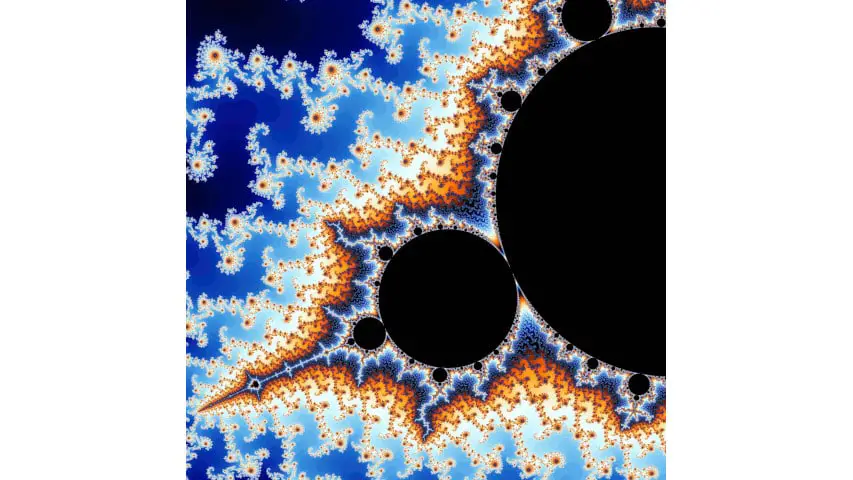Fractals are the confluence of mathematics and art. Found throughout nature, these self-similar patterns are endlessly fascinating, with a wide range of applications. Fractals have influenced technology, medicine, finances, and, yes, art.
Today we’re going to do a deep dive on fractals: what they are, their history, and what makes them so satisfying to look at.
Let’s dive in.
What Are Fractals?
Table of Contents
- What Are Fractals?
- What is Fractal Art?
- The Design Characteristics of Fractal Art
- Benoit Mandelbrot: The Father of Fractals
- The Aesthetics of Fractals
- A Study of Jackson Pollock
- The Impact of Aesthetics
- Artist’s Intuition
- The Complexity of Fractals
- Examples of Fractals
- Fractals Are the Past and the Future
- References
Fractals are never-ending, complex patterns that are described as “self similar” across different scales. This means their complexity is consistent no matter how much you magnify an area of them. Fractals are created through the repetition of a simple process and are images of dynamic systems – the very pictures of chaos.
Fractals are exceedingly familiar as nature is full of them. Rivers, trees, coastlines, clouds, seashells, and more are all examples of fractals. Abstract fractals are those that are generated by a computer that calculates a simple equation repeatedly.
What is Fractal Art?
A form of algorithmic art, fractal art is made by calculating fractal objects and displaying the results as still images, animations, and media. Their mathematical beauty sits at the intersection of computer art and generative art – combining to produce a form of abstract art.
Fractal art is rarely painted or drawn by hand, instead being generated with the use of fractal-generating software. This process happens in three phases:
- Setting the parameters of the appropriate fractal software
- Executing the potentially long calculation
- Evaluating the end result
Some artists post-process their fractal works, using other graphics programs to further change the images produced.
Fractal art was developed in the 1980s and makes for an endlessly fascinating art genre. Like numbers themselves, the possibilities for creating a unique piece of fractal art are never-ending.
The Design Characteristics of Fractal Art
There are a few commonalities when it comes to fractal art. These include:
Self-Similarity
This is a mathematical concept where an object will present similar to any part of itself. In visual design, this means that a zoomed-in part of an entire work will look similar to the whole (and vice versa).
Psychedelia
This artistic concept refers to altered consciousness and works that aim to recreate this mental state. These include distortions or surreal elements.
Intricate Patterns
This is a characteristic that’s connected to the previously mentioned self-similarity. This intricacy is witnessed in the sheer amount of detail and complexity of fractal patterns.
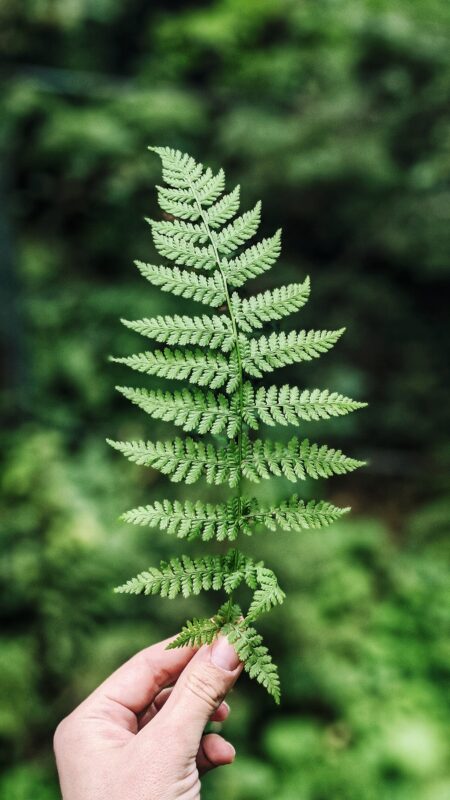
Mathematical Beauty
This is the premise on which all fractal art is based. It refers to the aesthetic enjoyment a person gets from the pure, simple organization of math.
Patterns in Nature
Fractals are found throughout nature – from clouds to seashells to mountains to trees. When a person admires algorithmic art, they’re admiring the natural world in a digitized form. If you want to learn all about fractals in nature and natural patterns, check out my complete guide.
Interested in generating natural looking maps and terrains? Check out my post about Wonderdraft! A computer based map generation tool.
Vivid Colors
One of the most striking features of fractals is the color in which they’re rendered. Whether manmade, natural, or digitized, amazing colors are a hallmark of this design trend.
Benoit Mandelbrot: The Father of Fractals
We can’t talk about fractals or fractal art without mentioning the pioneer of the creation: Benoit Mandelbrot.
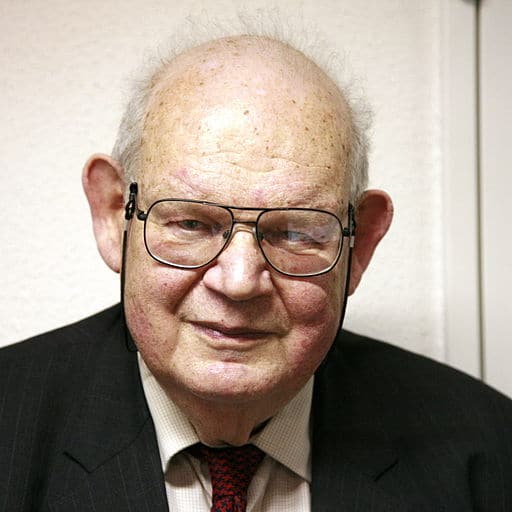
Born in 1924, Mandelbrot was a French-American mathematician and polymath with wide-ranging interests in the practical sciences. His focus was on what he called “the art of roughness” of physical phenomena – a focus that led him to the discovery and eventual naming of fractals.
While a visiting professor at Harvard University, Mandelbrot set to studying mathematical objects named Julia sets. Julia sets, invariant under certain transformations of the complex plane, had never been plotted as images before.
Mandelbrot changed that, using computers to investigate the topology of the sets. In doing so, he was able to pioneer using computer graphics to create fractal geometric images.
From his work with Julia sets came the advent of a set named in his honor: the Mandelbrot set. A set of complex numbers, the Mandelbrot set produces images that exhibit a detailed, infinitely complicated boundary that demonstrates progressively ever-finer recursive detailing at higher magnifications – in other words: a fractal.
Using mathematics and graphics, Mandelbrot demonstrated how visual complexity can be generated from simple rules – how seeming “chaos” actually has a measure of order. His work has had far-reaching effects on multiple industries from the financial to the medical to the musical. The artistic applications of his studies saw swift adoption and more and more people were drawn to the aesthetics of fractals.
Interested in doing a deep dive on Mandelbrot and his influential books? Check out my complete list of Mandelbrot’s books! If you would rather learn about the famous Mandelbrot Set, check out my post about the most famous fractal.
The Aesthetics of Fractals
Fractals are found throughout nature. One need only study a fern leaf to understand their familiarity. This familiarity goes a long way toward explaining why fractals are so satisfying to view.
We humans are visual creatures. Objects we call “aesthetic” or “beautiful” are a core part of what makes us human. One need only look at the oldest examples of cave and rock art, which served aesthetic roles, to understand their importance throughout history.
Though aesthetics is mostly regarded as a vague, ill-defined quality, some researchers are applying sophisticated techniques to quantify it as well as its impacts on observers. These studies have found that aesthetic imagery can cause massive changes in the body.
But what makes an image aesthetic? To put it simply: fractals.
A Study of Jackson Pollock
When it comes to the aesthetic, what better to study than the work of famous artists? Research groups took this approach with Jackson Pollock.
Pollock rose to prominence in the late 1940s through his works wherein he poured paint directly from the can onto horizontal canvases.
Pollock scholars are still at loggerheads regarding the meaning behind his splatter patterns, but most are in agreement that the result has a natural, organic feel.
Pollock’s paintings are enduringly popular, but why?
In 1999, researchers used computer pattern analysis techniques to prove that Pollock’s paintings are just as fractal as those found in nature.
The painter’s ability to express the fractal aesthetics of nature in his works goes a long way to explaining his popularity. [1]
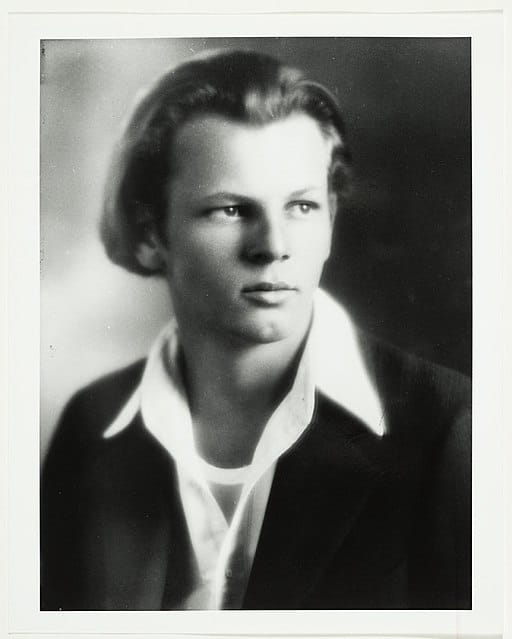
Want to learn more about Jackson Pollock and his unique artistic style? Check out my Jackson Pollock Style Guide!
The Impact of Aesthetics
The impact of natural aesthetics is wildly powerful. The 1980s saw architects discover that patients who were given hospital rooms with windows that faced nature recovered more rapidly from surgery. Since then, more studies have proven that just looking at pictures of natural scenes can alter the way a human’s autonomic nervous system deals with stress. [2]
All this begs the question: are fractals responsible for this phenomenon?
A team of researchers, collaborating with neuroscientists and psychologists, set out to find out. Their findings are fascinating.
They were able to measure people’s responses to fractals:
- Found in nature using photos of natural scenes
- Found in art by using Pollock’s paintings
- And found in mathematics using computer generated images.
The study discovered a universal effect that was coined “fractal fluency”.
Essentially, people’s visual systems have adapted to process fractals efficiently and with ease. This adaptation happens at multiple stages of the visual system, from which regions of the brain are activated to the way our eyes move. This ease induces a comfort zone in the viewer. In short, looking at fractals relaxes us.
Using skin conductance techniques and EEG technology, researchers were able to prove that a fractal aesthetic experience induces a stress reduction of 60 percent. [3]
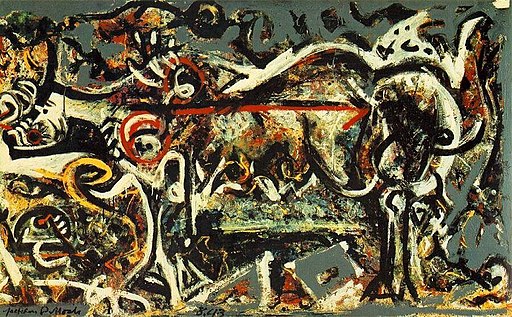
Artist’s Intuition
Artists are visual experts. As such, they’ve been drawn to naturally include fractal patterns in their works for centuries. Fractals are found in cross-cultural art, from Rome to Egypt to Mesopotamia.
Even though they’re common in art, fractals do present an artistic challenge. For example, many-a-forger has tried to fake Pollock’s fractals and come up short. In fact, fractal analysis can aid authorities in distinguishing fake from real Pollocks with a 93 percent rate of success. [1]
How artists develop fractals only adds fuel to the nature-versus-nurture debate in the art world. How much do automatic, unconscious mechanisms inherent in the artist’s biology determine aesthetics? Do cultural and intellectual concerns play a role?
In the case of Pollock, it’s both. The fractals in his work were a result of his body motions but he sunk ten years into consciously refining his technique. The result is a marked increase in the visual complexity of his fractals.
Do you like to draw or are you interested in using fractal patterns in your art or designs? Check out my post about how to draw fractals by hand! Want to know more about an entire area of artwork that uses fractal patterns for woodworking? Check out my post about the invention of Fractal wood burning!
The Complexity of Fractals
Pollock’s drive to increase the complexity of his fractals becomes apparent upon studying the fractal properties of Rorschach inkblots. These famous abstract blots are renowned because viewers see imaginary figures in them. This process can be explained using the fractal fluency theory. In essence, low complexity fractals make the fractal fluency process trigger-happy, fooling viewers into witnessing images that aren’t present.
Pollock is notorious for hating the idea that observers of his works would become distracted by such imaginary forms. This led him to intuitively increase the complexity of his fractals to prevent the phenomenon.
Interested in some of the mathematics around fractals? Check out this article about whether fractals are differentiable.
Examples of Fractals
There are a number of famous examples of fractal art throughout history both ancient and modern. Here are a few notable ones. There are also some excellent examples in the other posts in the fractal category.
Main Dome of the Selimiye Mosque
Located in Edirne, Turkey, the Selimiye Mosque is a beautiful example of the architectural application of fractals.
The Mosque itself is on the UNESCO World Heritage Site list and it’s easy to see why.
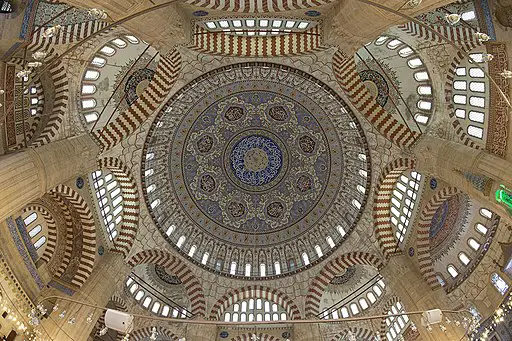
Its main dome alone is host to a series of stunning Islamic geometric patterns, which are exceedingly similar in design to the repeating sequences witnessed in fractals.
Hindu Temples
Another renowned, manmade creation that uses the power of fractals is the Hindu temple. These temples repeat patterns and shapes across the entire structure, containing numerous designs that are considered self-similar – the calling card of fractal art.
3D Fractal Ball
A famous digital artwork was created in Apophysis, the editor and renderer of fractal flames that’s available on both Windows and Mac.
When studied up close, one can notice all the tiles on the black ground are self-similar to the entire work. Everything down to the series of spheres in the center of the work displays the properties of fractal art.
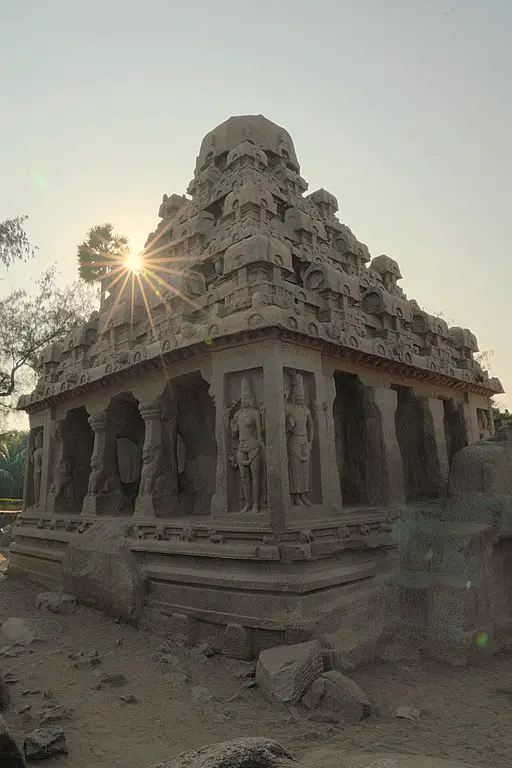
Chaotica Fractals
Created using the Chaotica program, these random fractals demonstrate what an artist can do with a program that includes the selective randomization of form inputs.
In short, it pushes the artist to give up a degree of control. These fractals can be less balanced or symmetrical than most other fractal illustrations. Despite this, one can still see how the various forms, patterns, and lines relate to each other and the design as a whole.
Electric Sheep
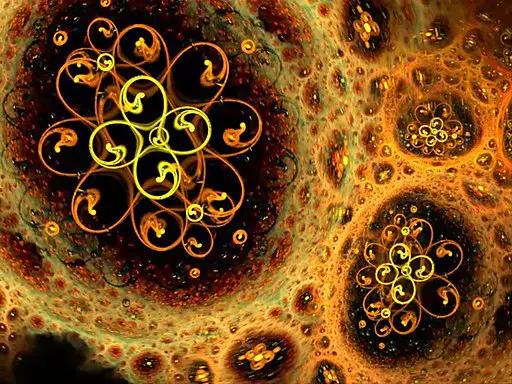
Electric Sheep is a collaborative abstract artwork created by Scott Draves. It’s developed by thousands of artists around the world and is able to be installed on just about anything.
The program runs when a user’s computer “sleeps”. From there, computers are able to communicate with each other via the internet to share the work of making abstract animations dubbed “sheep”.
The animations produced by Electric Sheep are fractal in nature. Self-similar and incredibly intricate, they’re a great example of digital fractals in action.
People then vote for their favorite animations using their keyboards. The sheep with more votes live longer and reproduce according to a specific algorithm with crossover and mutation. In short, the flock “evolves” to satisfy its global viewers.
Want to know some of the cool uses fractals have in the technology you use? Check out my post about fractals in technology!
Nautilus Shells
Found in nature, the nautilus shell shows off an interesting and intricate pattern while also demonstrating a logarithmic growth spiral. In other words, the self-similarity of fractals is evident in the development of the shell itself.
Sterling Fractals
Created with the Sterling computer program, these fractals are an awesome example of what an artist can do with mind-blowing, vivid colors. Displaying mainly warm colors, these designs calm the viewer in a massively serene fashion.
From a geometrical standpoint, it’s also a treat. It displays a number of swirls, vanishing points, curves, and other aesthetically pleasing forms.
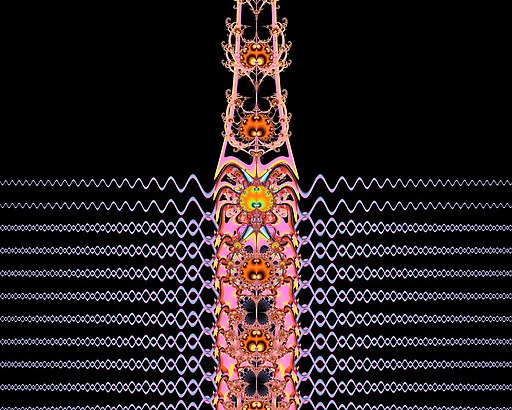
Fractals Are the Past and the Future
Fractals are endlessly fascinating phenomena. Whether you witness them in nature or in manmade art, their power to influence mood and soothe the mind is immense. Now you know everything there is to know about the history of fractals and art.
If you would like to learn about fractals generally, check out my post about the history of fractals.
Interested in reading more about Fractals? Check out some other posts in the Fractal Category.
Get Notified When We Publish Similar Articles
References
- Taylor, R., Micolich, A. & Jonas, D. Fractal analysis of Pollock’s drip paintings. Nature 399, 422 (1999). https://doi.org/10.1038/20833
- Ulrich RS. View through a window may influence recovery from surgery. Science. 1984 Apr 27;224(4647):420-1. doi: https://doi.org/10.1126/science.6143402
- Hagerhall, Caroline M., et al. Investigations of Human EEG Response to Viewing Fractal Patterns. Perception, vol. 37, no. 10, Oct. 2008, pp. 1488–1494, doi: https://doi.org/10.1068/p5918

